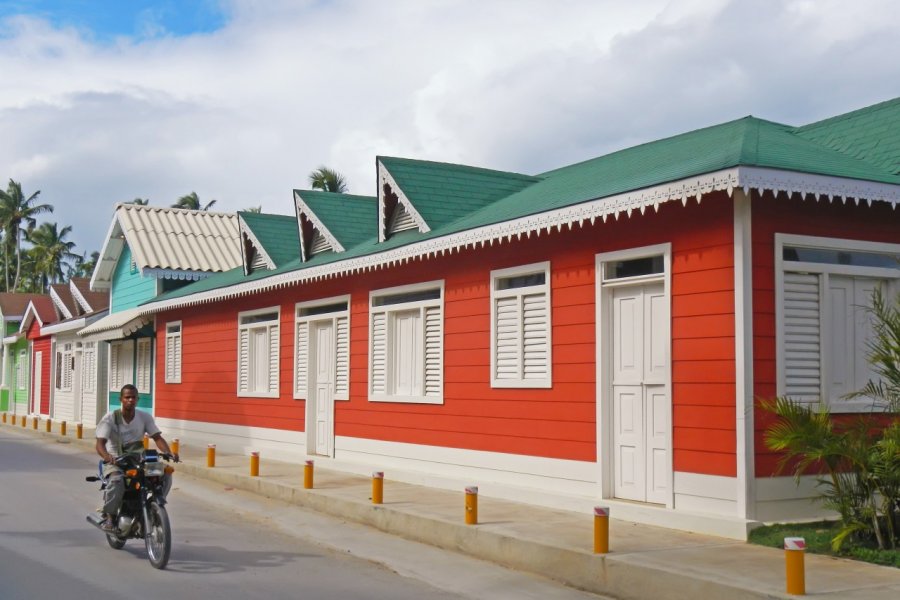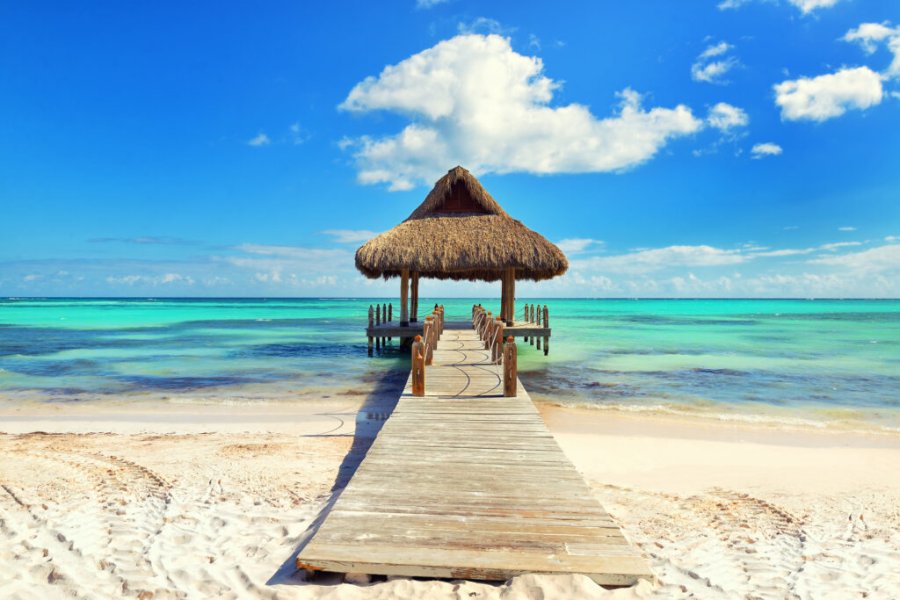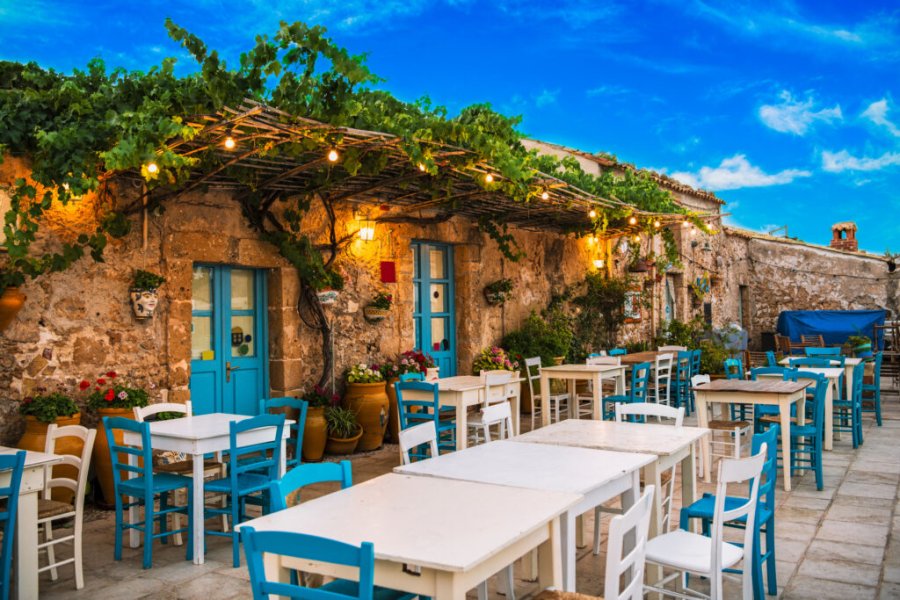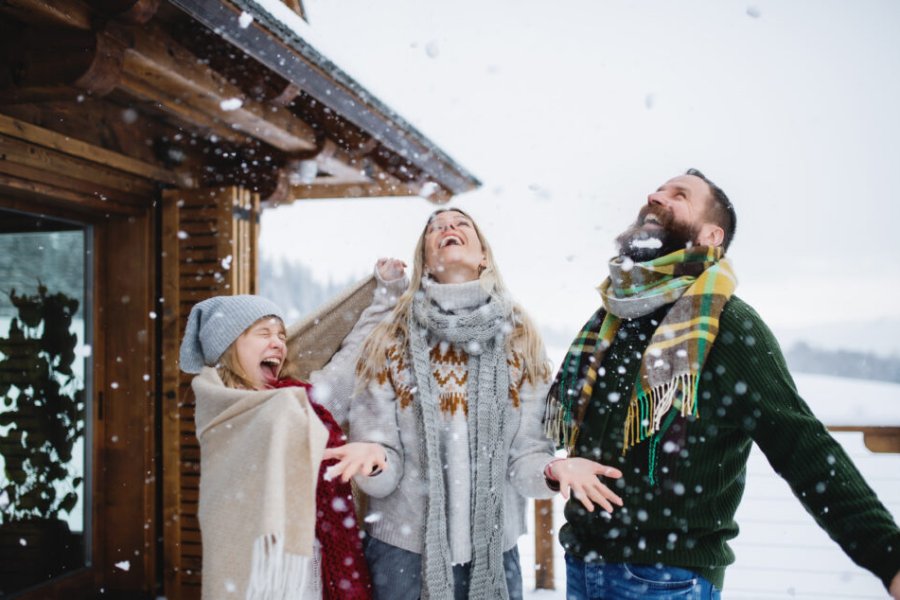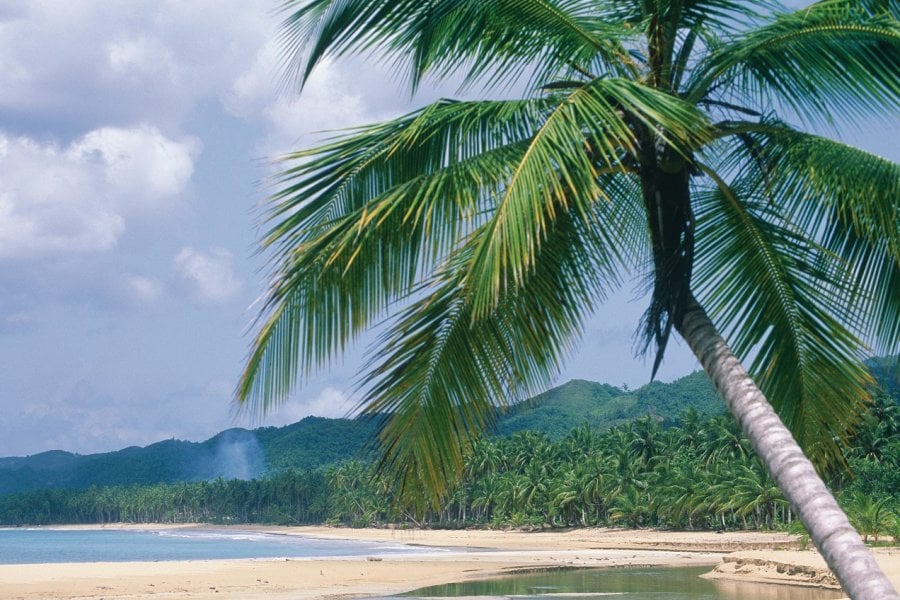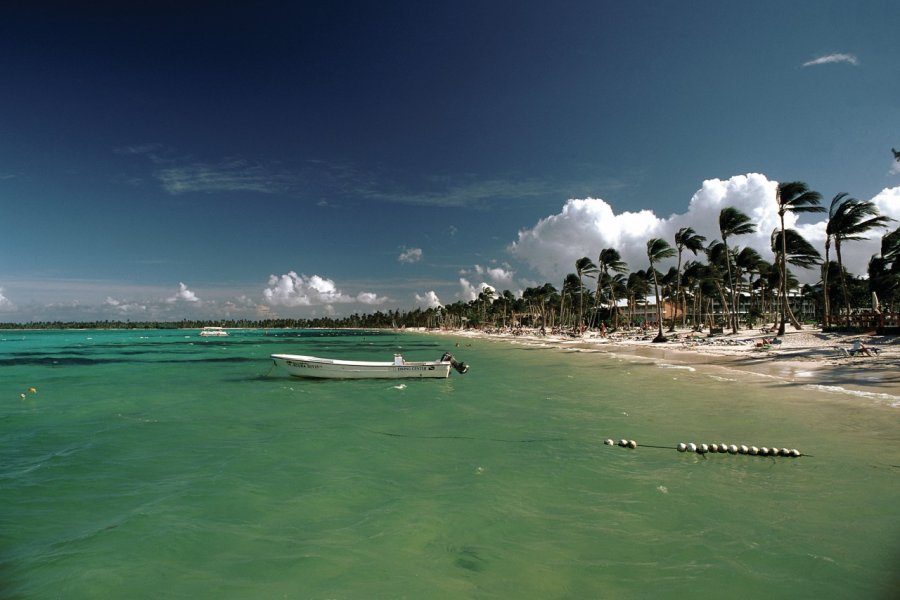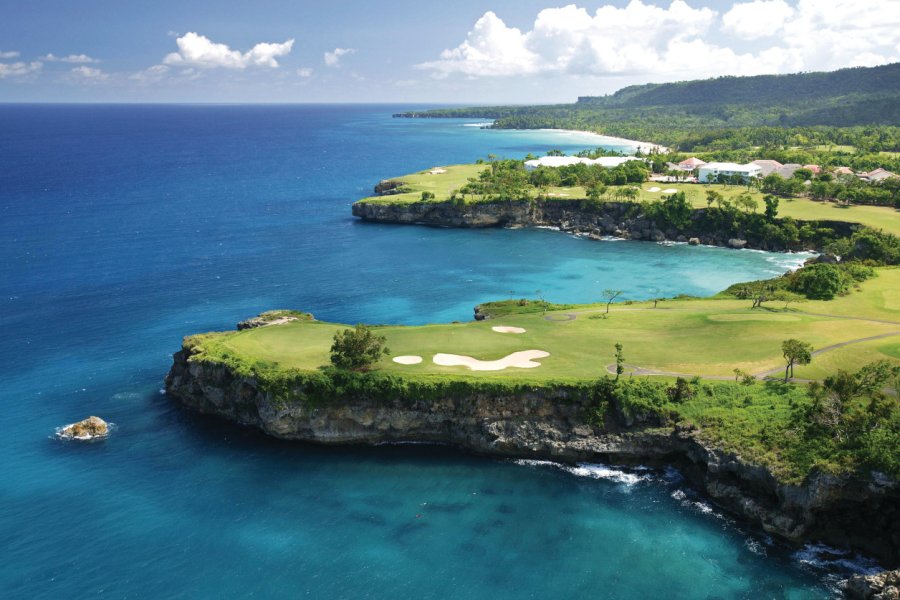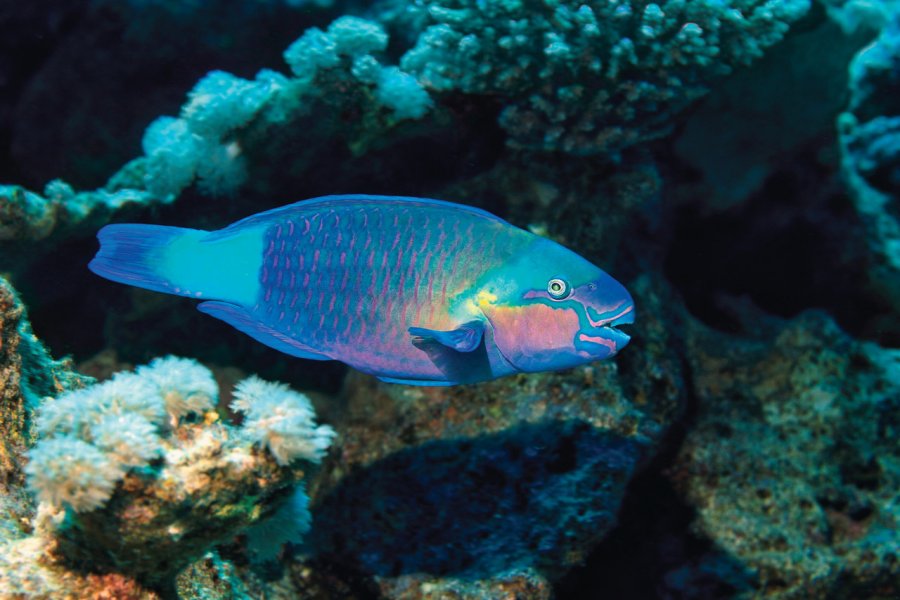Travel guide Dominican Republic
Miles of beaches with turquoise waters in Punta Cana, Santo Domingo and its colonial center full of charm, high-end hotels, golf courses scrupulously maintained, starred restaurants... These are the postcard images that come to mind when you leaf through a tourist guide to the Dominican Republic, but the island of Hispaniola conceals many other wonders... Try to climb Pico Duarte, the highest peak in the Caribbean in the center of the country. Watch the loving ballet of humpback whales in Samana. Find pink flamingos on one leg in a salt lake. Ecotourism is growing, giving pride of place to preserved and beautiful regions such as the southwest and the center. The other strength of the Dominican Republic is also its mixed population and its music obviously which resounds everywhere and at any time. The fiery dances, from merengue to bachata, give rhythm to the evenings and national celebrations. And this is only a foretaste of the multiple facets that you will be able to discover about the Dominican Republic!
What to see, what to do Dominican Republic?
-
Book an activity
-
Customized travel
- The most beautiful cities Dominican Republic
When to go Dominican Republic ?
You can travel all year round in the Dominican Republic. The high tourist seasons are between November and February, Holy Week before Easter, and July and August. Two seasons are favored by tourists, from mid-December to March and from July to August, with a clear preference for the first. The Holy Week before Easter with its famous red bean dish in April is also very popular. Of course, hotel and car rental rates take this into account. In the low season, however, a reduction of about 20% to 25% on the rates is in order. And you can negotiate! If you go to the Dominican Republic in January, go to Higüey on January 21 for the great procession for the feast of the Virgin of Altagracia, spiritual mother of the Dominican people. If you go to the Dominican Republic in February, don't miss the carnival which falls on the 27th.
Suggested addresses Dominican Republic
Travel Dominican Republic
-
Find a hotel
-
Car Rental
-
-5% on travel insurance-15% off travel insurance
-
Find a local agency
In case you do not opt for an organised stay or for a holiday in an all-inclusive resort, we have put together a few ideas for stays, each lasting one week. It is possible to combine these three itineraries to create a tailor-made holiday. The first suggestion is a week in and around the capital, which concentrates most of the country's cultural heritage, with short day trips to the southeast coast, easily accessible from Santo Domingo. The second idea of trip concentrates on the Dominican coasts, all more beautiful the ones than the others, so that it is possible to extend to two or even three days each stage of the trip. The third proposal is aimed at sportsmen, combining scuba diving, hiking, board sports, climbing, golf... Pick and choose as you wish!
Find unique Stay Offers with our Partners
How to go Dominican Republic
How to go alone
The international airport Las Américas of Santo Domingo is located 25 km east of the city (30 min by cab). The usual precautions are obviously recommended for people traveling alone (go out with a small amount of money, do not get into a cab, do not change money in the street...), but the Dominican Republic is a generally safe country. However, in the southwest, mainly in the region of Barahona, it is strongly advised not to drive after dark.
How to go on a tour
Most tour operators offer trips to the Dominican Republic with all inclusive stays of 10 to 15 days. These trips are generally excellent value for money if you intend to stay in a hotel, with your feet in the water. But if you intend to visit the country, it will be necessary to make excursions and the prices are generally not given then take care to inform you in advance to avoid the bad surprises.
How to get around
Domestic flights are quite expensive but useful for such a short time. The bus network is dense with a good frequency, good comfort and good prices. For more mobility, you can rent a car. The only regular maritime line is the ferry between Samaná and Sabana de la Mar, but cancellations are not uncommon due to bad weather conditions.
Featured articles Dominican Republic
Discover Dominican Republic
A country that we like to think of as a huge open-air all-inclusive resort, with its paradisiacal beaches lined with coconut palms, where delicious laziness is the order of the day, the Dominican Republic is also one of the first lands "discovered" by Christopher Columbus. In fact, its history is that of the odyssey of European discovery of the New World, from the disastrous first encounter with the "Indians" to slavery and successive independence... The eastern two-thirds of the island of Hispaniola are home to a wealth of geological, faunal, social, artistic, linguistic and gastronomic features, and it's this richness that the dossiers presented here invite you to explore. You'll also learn more about merengue and bachata - two styles of music and dance that originated in the country - and the art of the Dominican cigar.
Pictures and images Dominican Republic
The 12 keywords Dominican Republic
1. #Bachata
This danceable, folkloric rhythm, which originated in the Dominican Republic, became popular in the 1960s and especially since the 1980s with the development of tourism. The bachata is a mixture of bolero, musical influences of African origin and other sounds evoking the merengue, the cha-cha-cha or the tango. Typical!
2. #Baseball

Baseball (or béisbol) is the national sport par excellence, followed with fervor by an entire nation: attending a game in the Dominican Republic immerses you in an authentic, local atmosphere! The sport arrived here with Cuban sugar cane planters fleeing Cuba during the Ten Years' War (1868-1878).
3. #Carnival
Carnival in the Dominican Republic is one of the most incredible in the Caribbean. What makes it so special is that it takes place twice a year, on the anniversary of national independence day (February 27) and the anniversary of the restoration of the Republic (August 16). Masked parades, rum and good cheer!
4. #Redshirt
If you see someone waving a red rag at the side of a road, be careful! It means animals in transit or roadworks. Slow down! The herd, or even a single cow, is usually behind the next bend in the road. Some vehicles also hang this piece of cloth to indicate a balanced load.
5. #Concón

This is the part of the rice that sticks to the bottom of the pan and is slightly burned when it is prepared. It is customary in all families after finishing the first service to ask enthusiastically who wants concón, which is usually served with red beans. Dominicans love it, and we recommend it...
6. #Colmado
These must-visit grocery stores are more than just shops: they're meeting places where you can enjoy a drink, chat with your neighbors and relax. In Santo Domingo, some are veritable institutions, like the one in Plaza Duarte, while others are trying out new trends, like Coolmado de las Mercedes.
7. #Dominos

It's the traditional men's game, played all over the island and at all hours. A rickety table and a few chairs are all that's needed for players to set up and improvise a game that can last for hours. Particularly skilful, the players hold the dominoes in one hand and rattle them noisily as they come down on the board.
8. #Dame una bola!
This is the phrase to use when hitchhiking in the Dominican Republic. In rural or poorly served areas, you can ask a driver to give you a lift by waving. However, always be careful not to put yourself in danger by making sure that the person is well-intentioned.
9. #Gallera
Almost every village has its own gallera, the arena where cockfighting takes place, a popular and highly prized pastime. The fights take place on weekends. As the fights get underway, the betting public gets excited, and the atmosphere is often electric. A practice which nevertheless remains ethically questionable.
10. #Merengue
Classified as a UNESCO World Heritage Site in 2016, merengue is a major part of the country's culture. While the locals love to dance to some twenty different rhythms, the most famous remains the merengue, a blend of Spanish and African culture, influenced by the güira, an instrument made of a cylindrical brass rasp on which a scraper is rubbed.
11. #Moto concho
While it's the cheapest way to get around the Dominican Republic, it's far from the least dangerous. Since 2006, motos conchos (short for moto con chófer - motorcycle with driver) have formed a union, and prices should be more or less the same everywhere, but in reality they are not. Don't hesitate to negotiate.
12. #Plátano

This is plantain banana, low in sugar but high in starch, which makes it firmer and more resistant to cooking. Very abundant, it is one of the most widely consumed foods. It can be prepared in many different ways, fried or mashed, sweetened or salted, for example tostones (fried slices).
You are from here, if...
You learned to dance bachata and merengue before you learned to walk. You can even dance without music.
You can smell smoked pork chop cooking at home while you're out.
You were afraid of cuco when you were a kid.
You spill rum on the floor and exclaim: Eso e pá lo muerto!
You drink Brugal, Presidente or Mamajuana as if it were water.
You eat mangu or fried plantains with ketchup.
You use words like gile (gilette: razor), vivaporu (vix vaporub), poloche (poloshirt: t-shirt), guachiman(watchman : guard), confle (corn-flakes: cereal).
One of your favorite expressions is: Anda el diablo! - Coo - El diache! - Que vaina! - Dímelo - Ta Tó! - Y es fácil... ! - Qué lo qué? - Ahhh... Po tá bien ! - Que tripeo - Tu si jode - Tá cool - Tá jevi - La creta! - Tu tá pasá - No le dé mente! - Cójelo suave! - Que bufeo! - No te quille - Degrasiá !

